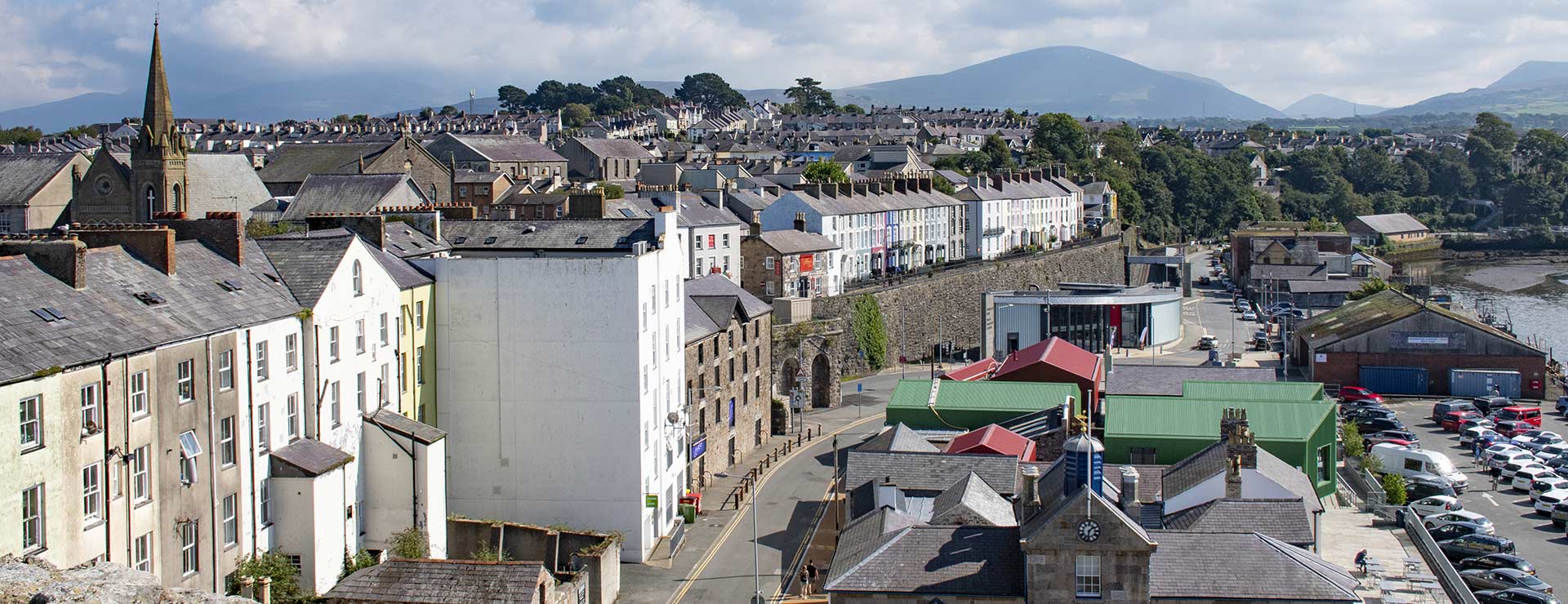(Click here for Ffestiniog Railway history)
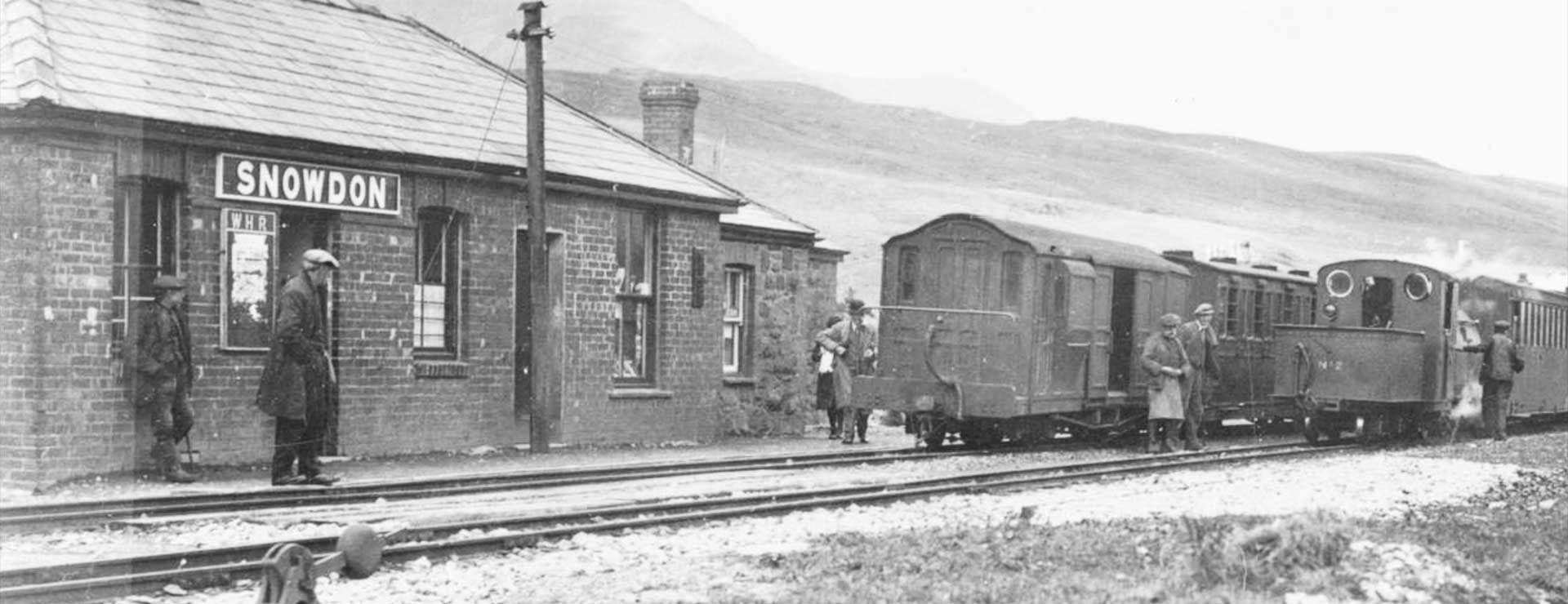
The origins of what was to become the Welsh Highland Railway (WHR) can be traced back to a number of narrow gauge railway developments: the Nantlle Tramway, the Croesor Tramway, the Portmadoc, Beddgelert & South Snowdon Railway (PBSSR) and, perhaps the best known, the North Wales Narrow Gauge Railways (NWNGR).
The Nantlle horse-drawn railway was opened in 1828 with a nominal gauge of 3ft 6in, and wagons with double-flanged wheels, to connect the slate quarries at Nantlle with Caernarfon, a distance of about eight miles.
It was converted into a standard gauge railway in the 1860s (albeit on a slightly different alignment) by the Caernarvonshire Railway as part of their route to Afon Wen, leaving the Nantlle Tramway shortened to serve a new trans-shipment point at Talysarn until the 1960s when it finally closed.
The WHR didn’t reach Caernarfon, despite many attempts starting back in 1885, until 1997 as the first phase of the revival. Fragments of the old Nantlle Tramway route between Dinas and Caernarfon, including a bridge and two tunnels, still survive, well over 100 years after the route was abandoned.
The Croesor tramway was built in 1864 and also consisted of a horse-drawn tramway on iron rails but at 2ft gauge. It carried slate from the quarries at Croesor to Portmadoc (now Porthmadog). Later, the Cambrian Railway was to cross the Croesor route on the level and this would later become a factor in the declining fortunes of the WHR.
The North Wales Narrow Gauge Railways (NWNGR) were conceived and engineered by Charles E Spooner (who was secretary and engineer of the Festiniog until 1887 and also owned a quarry at Bryngwyn). The company initially proposed a network of eight lines, serving areas as far spread as Betws-y-Coed, Pwllheli and Corwen, a total of some 60 miles. However, only two of these were ever built. The first line to be constructed ran from Dinas (three miles from Caernarfon) to Bryngwyn (just over 5 miles from Dinas).
Construction began in 1873, but was not completed until 1877. At the same time, the contractors continued on to Rhyd Ddu (the station called Snowdon originally) and the full line (officially two lines, linked at Tryfan Junction) opened in 1881, mostly serving the slate quarries at Bryngwyn and Glan yr afon. Goods transferred to the standard gauge line at Dinas Junction for the short trip to Caernarfon. It wasn’t just slate and quarry workmen that the railway carried. The railway made the most of being the closest to the summit of Snowdon, so tourists were also encouraged by advertising the wonderful scenery and of access to paths up Snowdon.
In 1901, the Portmadoc, Beddgelert & South Snowdon Railway (PBSSR) was promoted to take over the Croesor Tramway and extend it to Nant Gwynant via Beddgelert; an Act of Parliament authorised the takeover and construction of a hydro-electric power station in Nant Gwynant and electric railway operation. The ‘South Snowdon’ part of the title referred to the South Snowdon slate quarry, a possible source of traffic at the Beddgelert end of Nant Gwynant. In 1904 the power station was devolved to the North Wales Power & Traction Company; the power station was the only part of the 1901 enterprise completed and is still generating.
Construction was started in the Aberglaslyn Pass in 1905. The NWNGR had obtained a Light Railway Order to extend to Beddgelert in 1900 and those powers were transferred to the PBSSR in 1906, leading to construction activities between South Snowdon and Beddgelert. As part of the agreement to take over the NWNGR powers, and to refurbish and electrify that line, the PBSSR ordered the Hunslet steam locomotive, Russell, to help keep the NWNGR going. However, money ran out and construction came to an end, leaving the tunnels in the Aberglaslyn Pass and other earthworks abandoned.
The NWNGR and Croesor Tramway continued as before, with the NWNGR becoming increasingly run down. During the First World War its passenger service ended.
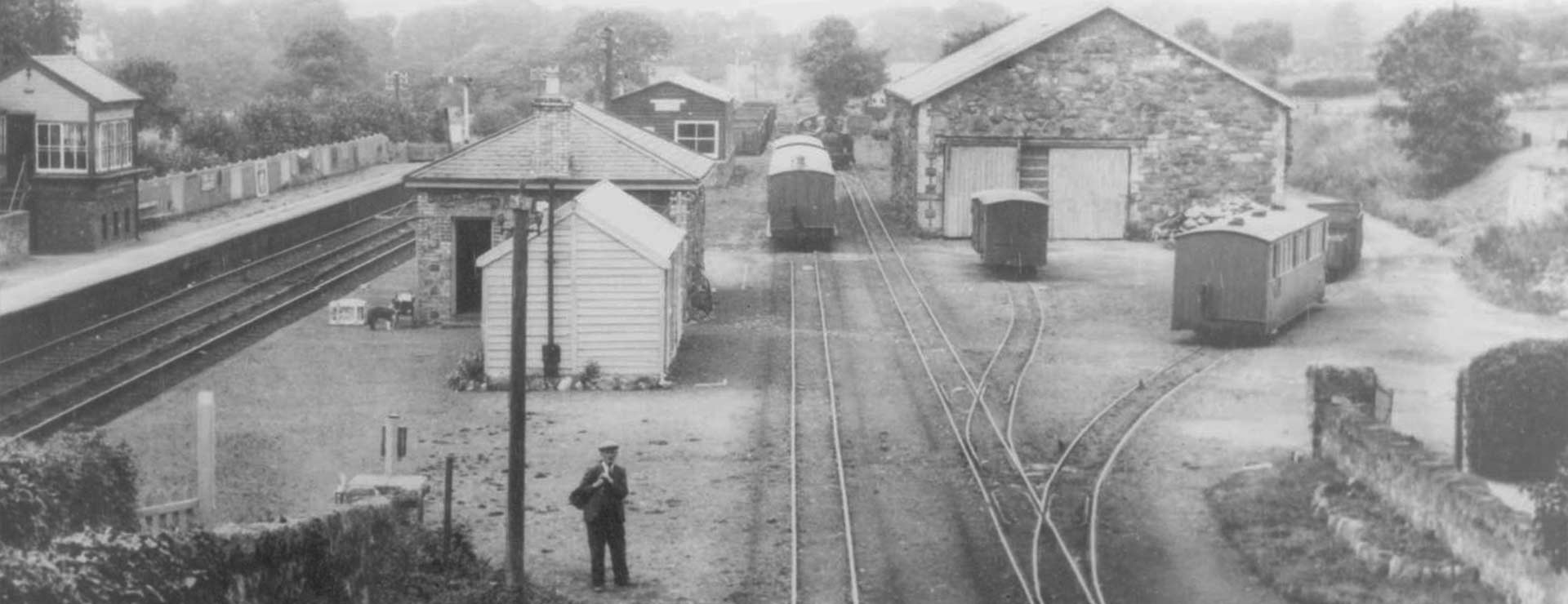
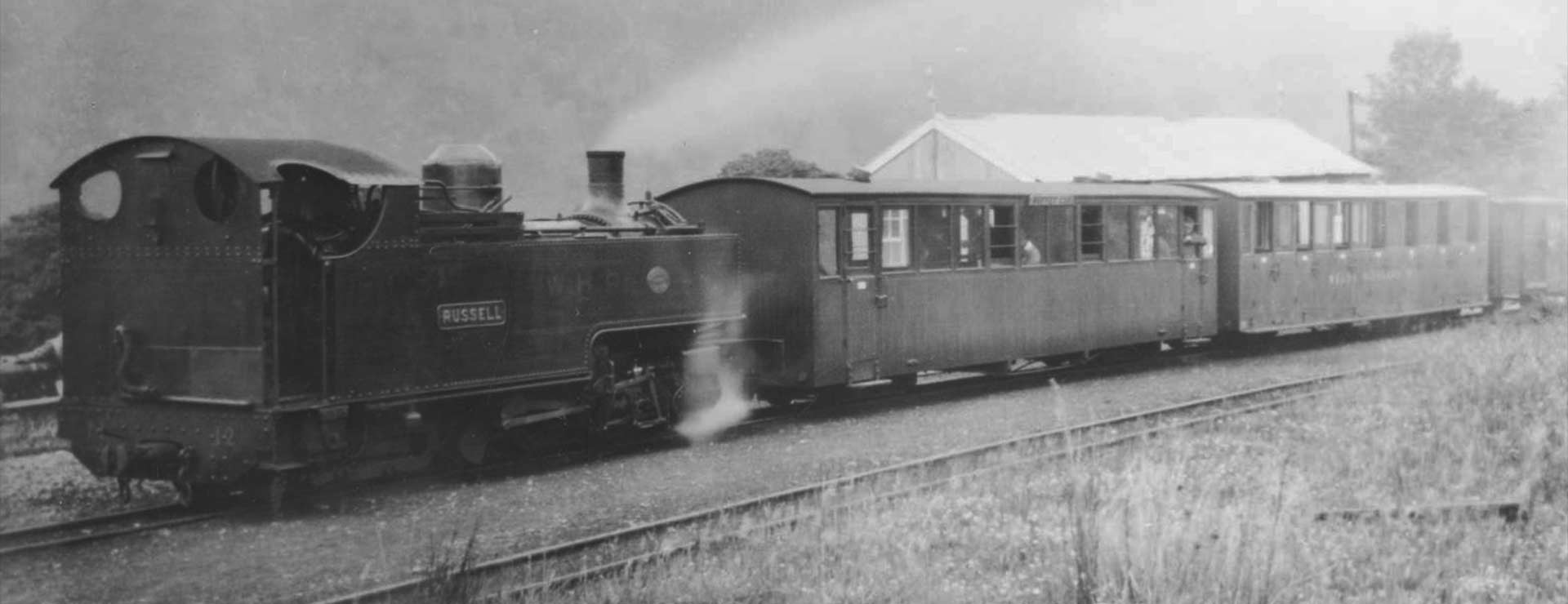
In 1914 the local authorities promoted a Light Railway Order to take over the PBSSR and NWNGR and complete the unfinished railway. In 1920 the application was reactivated by the Dolgarrog-based Aluminium Corporation, which had acquired control of the PBSSR and the NWNGR, and an order was made to create the Welsh Highland Railway (WHR) in 1922.
The WHR was mainly funded by loans from the Ministry of Transport and the local authorities, however, these loans were to lead to the WHR’s downfall because it could never earn sufficient to pay the interest.
The WHR let the contract for construction to McAlpine & Sons to refurbish the NWNGR and Croesor Tramway and construct the ‘missing’ line between Rhyd Ddu and Croesor Junction, thus completing the link between Dinas and Portmadoc. The FR built the connection railway in Portmadoc and a new joint station there. The NWNGR section was reopened in 1922 and the line was opened throughout in 1923.
The two remaining original NWNGR locomotives (Russell and single Fairlie Moel Tryfan) were supplemented, in 1923, by an ex-War Department Baldwin 4-6-0T No. 590. However, there were still shortages of equipment and most of the FR’s England locomotives and carriages saw use on the line.
The WHR was in trouble from the start; 1923 was the best year for traffic and it declined each year thereafter. In conjunction with the LMS and GWR, the FR and WHR were promoted as a circular tour but, despite this and other marketing initiatives, a profit was never shown. In 1923 interest on the loans was paid from capital; no more was ever paid. After the winter of 1923/4 the passenger service became seasonal and the goods service run pretty much as required.
Colonel Stephens, known for running a collection of poorly off light railways, had been appointed engineer in 1923 and a director in 1925 but even his expertise could not save the WHR. The slate industry was declining, tourists were discovering the delights of charabancs, locals the convenience of motor buses and cheap ex-military lorries were coming on to the market and the WHR stood little chance. The railway was put into receivership in 1927.
Despite this, there was enough revenue to keep the railway going, just. Hope remained, and following a good 1933 season, the FR put forward a plan to operate the two railways from 1934.
A 42-year lease on the WHR was signed, although this required the FR to pay rent even if the railway made an operating loss! The railway continued to perform poorly and the last passenger train ran on 5th September 1936. In December 1936, the FR asked to be released from the lease and all traffic on the WHR was formally suspended from 1st June 1937.
In 1941 much of the railway’s equipment was requisitioned for the war effort with one portion of track even used for mobile target practice! The Croesor section was left in situ in case the quarries reopened after the war; but was finally lifted in 1948. Various legal manoeuvres followed this, including a serious application to turn the route into a long-distance footpath. Although these plans were ultimately unfruitful, they probably ensured that the trackbed was kept mainly intact, rather than sold off bit by bit. However some parts such as the site of Rhyd Ddu station were sold off.
Of the locomotives, Moel Tryfan had been dismantled at Boston Lodge since 1934 and was eventually cut-up for scrap, in a bid to raise much needed finance for the early preservationists at the FR. However Russell went to work in Oxfordshire, and then in Dorset, before being saved by the Birmingham Locomotive Club for fifty pounds and moved to the Talyllyn Railway for display. Since then it has been fully restored and although currently being overhauled, it will see use on WHR heritage trains come the full reopening of the line.
The section between Dinas and Caernarfon (previously the Caernarvonshire Railway) was taken over by the London & North Western Railway in 1870, becoming in turn part of the LMS Railway in 1923. The line was finally closed by British Railways in 1964, following which the local authority purchased the trackbed to develop the Lon Eifion cycle track.
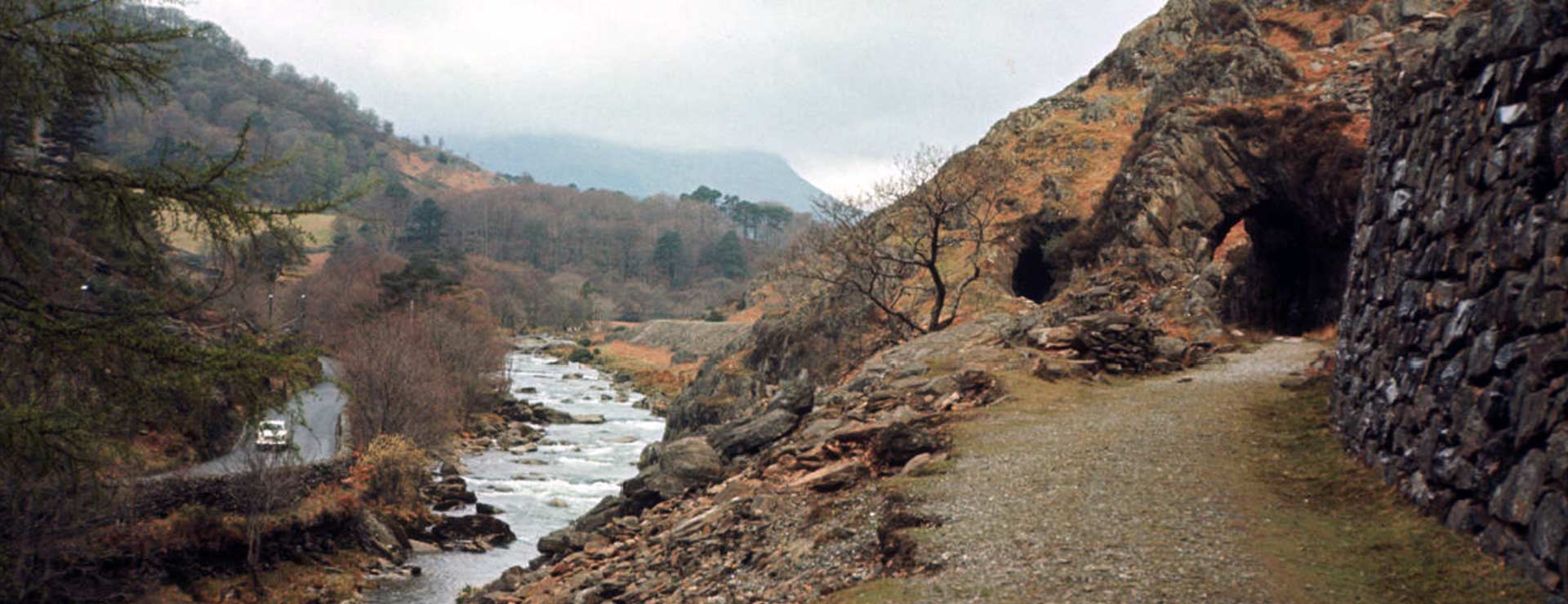
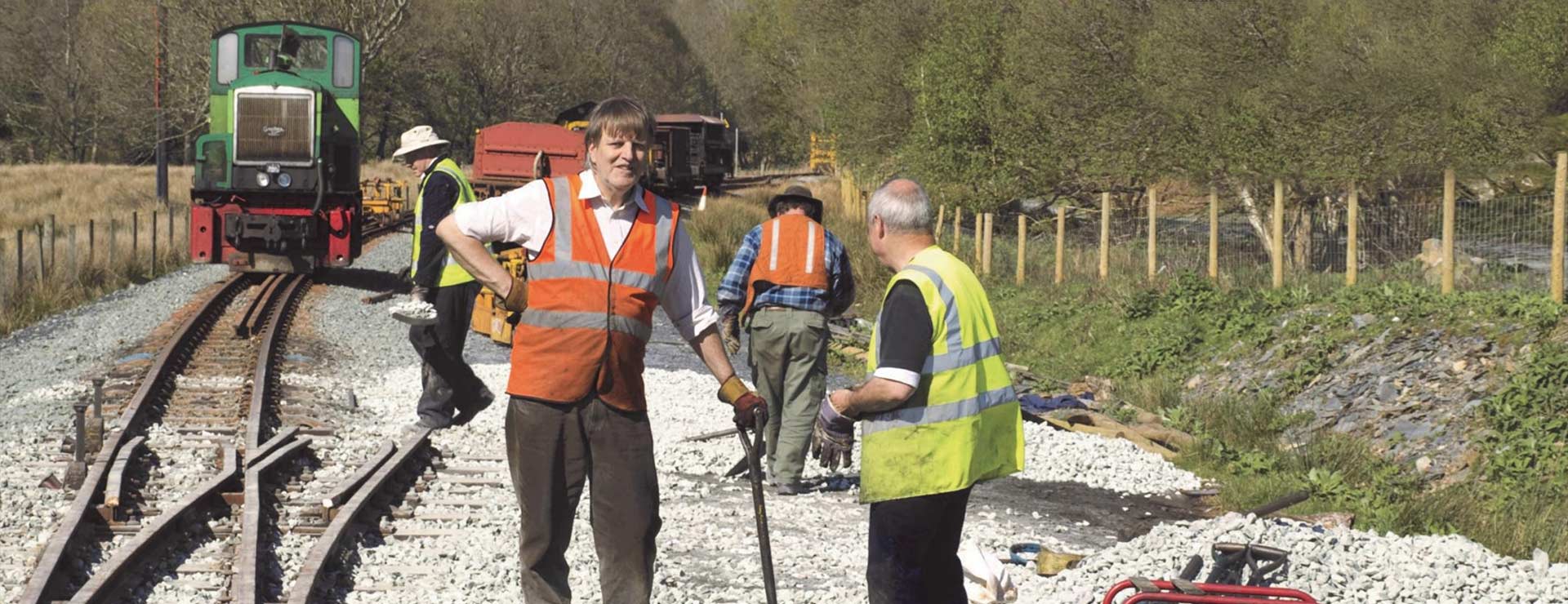
In the early 1960s the first determined efforts to revive the WHR began and in 1961 a group of enthusiasts formed a society which became the Welsh Highland Light Railway (1964) Co Ltd. Negotiations were opened with the liquidator, A. Thomas, but these efforts necessarily changed focus when he died and the assets were transferred to the Official Receiver in London.
A base was eventually established on a former standard gauge siding in Porthmadog and a short length of line was laid to Pen y Mount. A public service commenced in 1980.
WHLR (1964) Ltd opened negotiations with the local authorities and the Official Receiver but the company’s efforts were complicated by the threat of road improvement schemes which apparently required portions of the trackbed too.
In the late 1980s, the FR became again involved in WHR interests, having completed restoration of the FR route, including a 2½ mile deviation, to Blaenau Ffestiniog in 1982.
In 1989 it was a matter of some controversy when it became known that the FR had made a secret bid to acquire the WHR trackbed from the Official Receiver. The FR plan was to start at Caernarfon, rebuilding back to Porthmadog and connecting with the FR to create a 40 mile railway – a new ‘Great Railway Journey’.
In 1993 the Welsh Highland Railway Society was launched to focus volunteer efforts for the reconstruction of the WHR.
There then followed several years of legal arguments, a High Court hearing and three public inquiries, and an appeal before a decision that the reconstruction of the WHR was in the public interest was made and the necessary powers granted by means of a Transport & Works Order. Along the way a transfer order sanctioned the sale of the trackbed from the Official Receiver to the FR and a Light Railway Order authorised the Dinas-Caernarfon section.
Work started between Dinas and Caernarfon in 1997 and engineering contractor Mowlem made the trackbed ready for volunteer tracklayers. It was opened on 13th October 1997, with initial trains consisting of five new carriages. Subsequently a Pullman car, Bodysgallen, and two more semi-opens were added to the fleet. Some FR stock was also used and many FR locos have made appearances on the WHR from time-to-time.
From an early stage the railway was envisaged to be reconstructed to operate at as close to 25 mph as possible, to be operated by powerful locomotives capable of hauling 12 coaches up gradients of up to 1 in 40 and in such a way as to reduce long-term maintenance costs. A large amount of the necessary equipment was sourced from South Africa including two NG/G16 2-6-2+2-6-2 Beyer Garratts (Nos 138 and 143) and the Funkey diesel Castell Caernarfon. Another Funkey diesel was also imported and after a significant rebuild entered service on the FR as Vale of Ffestiniog. A third NG/G16, No 140, was donated to the cause in 1997 and two NG15 2-8-0s were subsequently obtained.
Funding was made available towards the estimated £9 million cost of rebuilding to Rhyd Ddu from the Millennium Commission (£4.3m), European Regional Development Fund, Welsh Development Agency, Wales Tourist Board and sponsorship from the WHR Society, Historic Houses Hotels and First Hydro.
The section to Waunfawr took about a year to finish, opening in August 2000 and work started almost immediately on the next section to Rhyd Ddu. However, progress was hampered by the national Foot and Mouth disease outbreak.
In early 2003, tracklaying started at Rhyd Ddu northwards to meet up with the section being laid from Waunfawr southwards. Following test running and a visit by HRH Prince Charles, the Prince of Wales, the railway was opened to Rhyd Ddu on 18th August 2003.
Whilst these developments were taking place WHLR (1964) Co, now registered as the Welsh Highland Railway Ltd, reached agreement with the FR to rebuild the railway to Pont Croesor – and to operate trains of heritage rolling stock on this section of line until it was required for completing the route to Harbour Station. In 2003 work started for an initial extension to Traeth Mawr loop, about half way to Pont Croesor, but progress was also hampered by the Foot and Mouth outbreak. WHRL completed this initial section to Traeth Mawr loop and operated a regular service over it during the 2008 season.
In September 2004, the FR announced that funding of £5m had been forthcoming from the Welsh Assembly and the EU. This, together with funds from a hugely successful public appeal, finally meant that the full project would come to fruition.
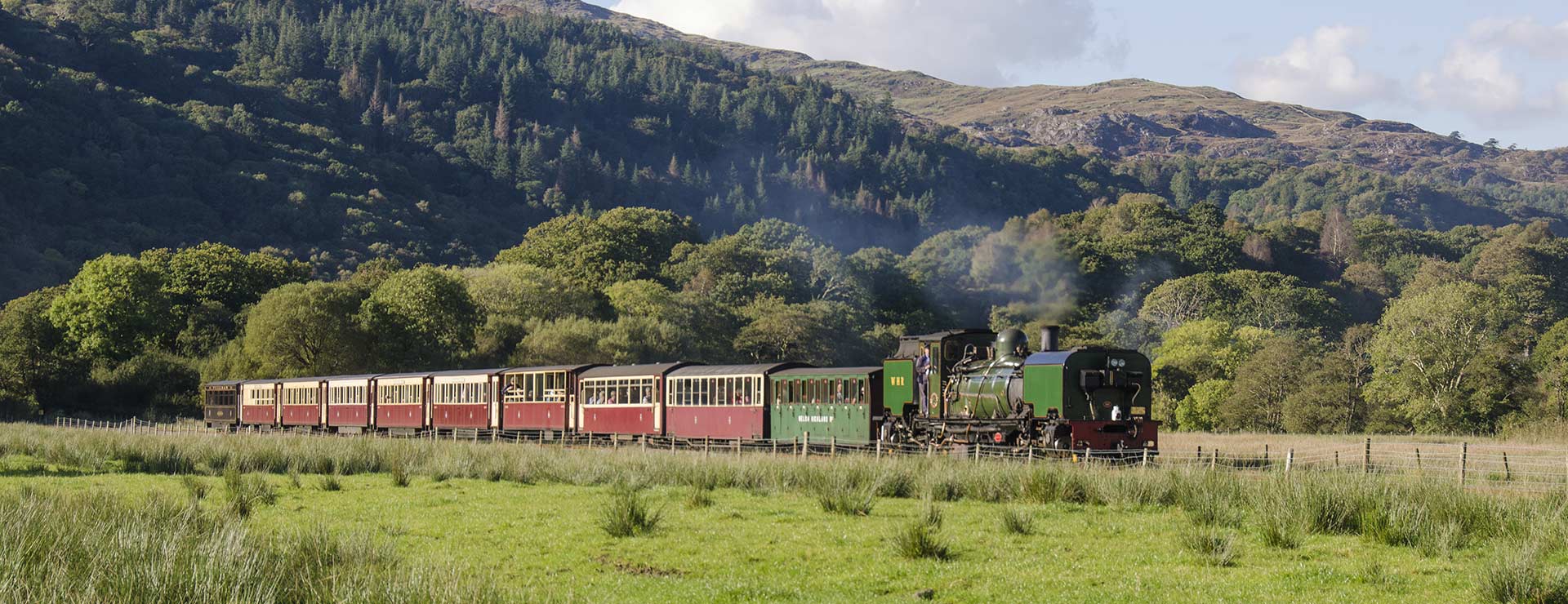
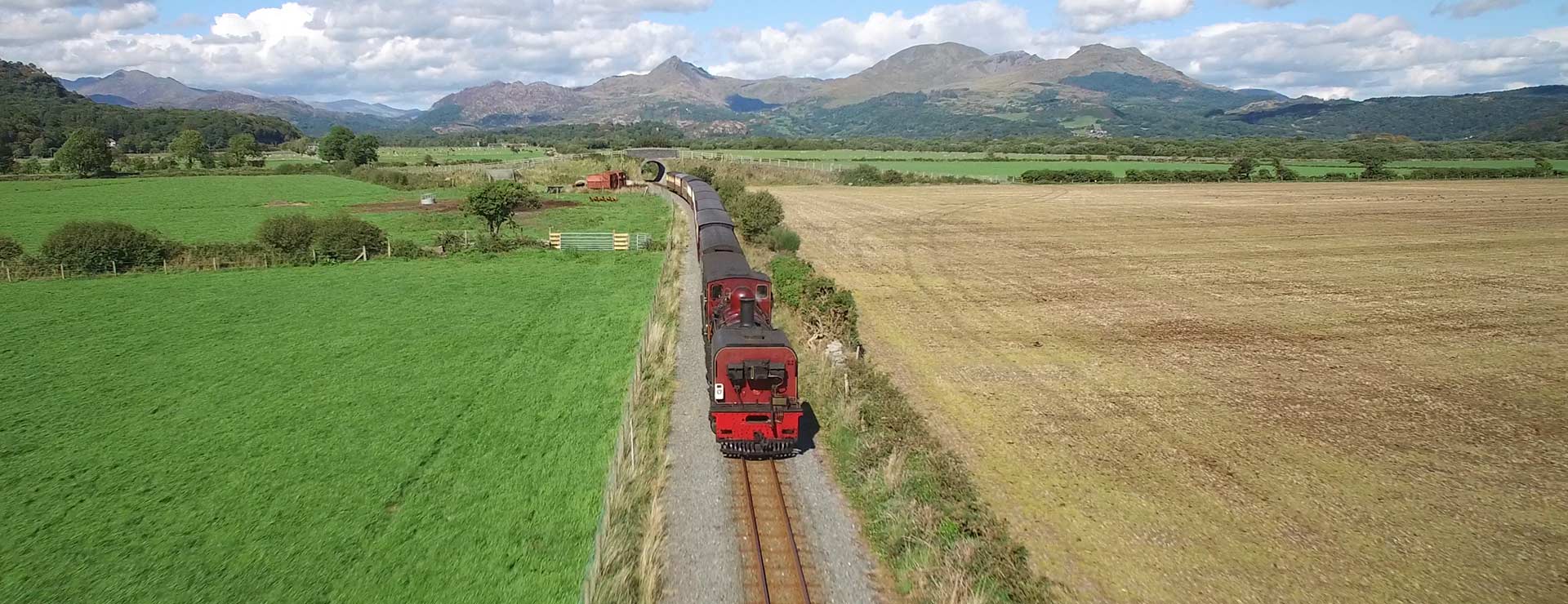
Phase 4 involved the rebuilding of the railway from Rhyd Ddu through Beddgelert and Aberglaslyn to Porthmadog in one go. This final phase includes street running across Britannia Bridge to link with the FR at Harbour Station, four tunnels, four large river bridges, a crossing of the standard gauge Cambrian coast line on the level and over 12 miles of track.
Work started in summer 2005 with the completion of Rhyd Ddu station (with two new water towers, an extended platform and a small yard) in early 2006. Following clearance, drainage and ballasting works by contractors, volunteer tracklayers laid track all the way to Porthmadog, the missing bridges were replaced, the flat crossing over the Cambrian Coast line installed and road crossings have been built.
The railway’s original fleet of two NG/G16 Beyer-Garratts – Nos.138 and 143 – has been augmented by the arrival of NG/G16 No.87, which has been rebuilt at the Ffestiniog Railway’s Boston Lodge Works after a private donation covering the costs of purchase and restoration was forthcoming. This coal-fired locomotive entered service in early 2009.
The Welsh Highland Railway Society is supporting a volunteer-led team restoring NG15 No.134. This 2-8-2 tender loco will provide an interesting contrast to the railway’s fleet of articulated locos.
New carriages have also been built at Boston Lodge for use on the Welsh Highland Railway increasing the level of passenger comfort offered – as well as providing dedicated wheelchair accommodation and accessible seating. A new Observation Pullman Carriage entered service in 2009 and was named Glaslyn by Her Majesty the Queen when she visited the railway in early 2010. Further improvements have been the introduction of on-train toilets and new service cars with enhanced facilities for hot and cold buffet service.
The new Welsh Highland Railway has been developed on a much more substantial financial and engineering basis and is already making an environmentally-sensitive contribution to the economy of the area – independent research shows that the two railways generate over £15 million for the local economy each year and create more than 350 jobs in the surrounding area.
Public services started to Beddgelert, then Hafod y Llyn in 2009 and Pont Croesor in 2010. The final link to the FR is now open, finally enabling through services to operate between Blaenau Ffestiniog and Caernarfon.
But even with the tracklaying phase complete, the railway is far from finished. There are station buildings to be completed and new carriages to be built. All this will take time, effort and money, as will the never-ending task of maintaining a 40 mile railway and 80 miles of fencing.
Railways are never ‘finished’, so why not ask how you can help the Ffestiniog and Welsh Highland keep their place as the very best heritage railways in the UK, if not the world!
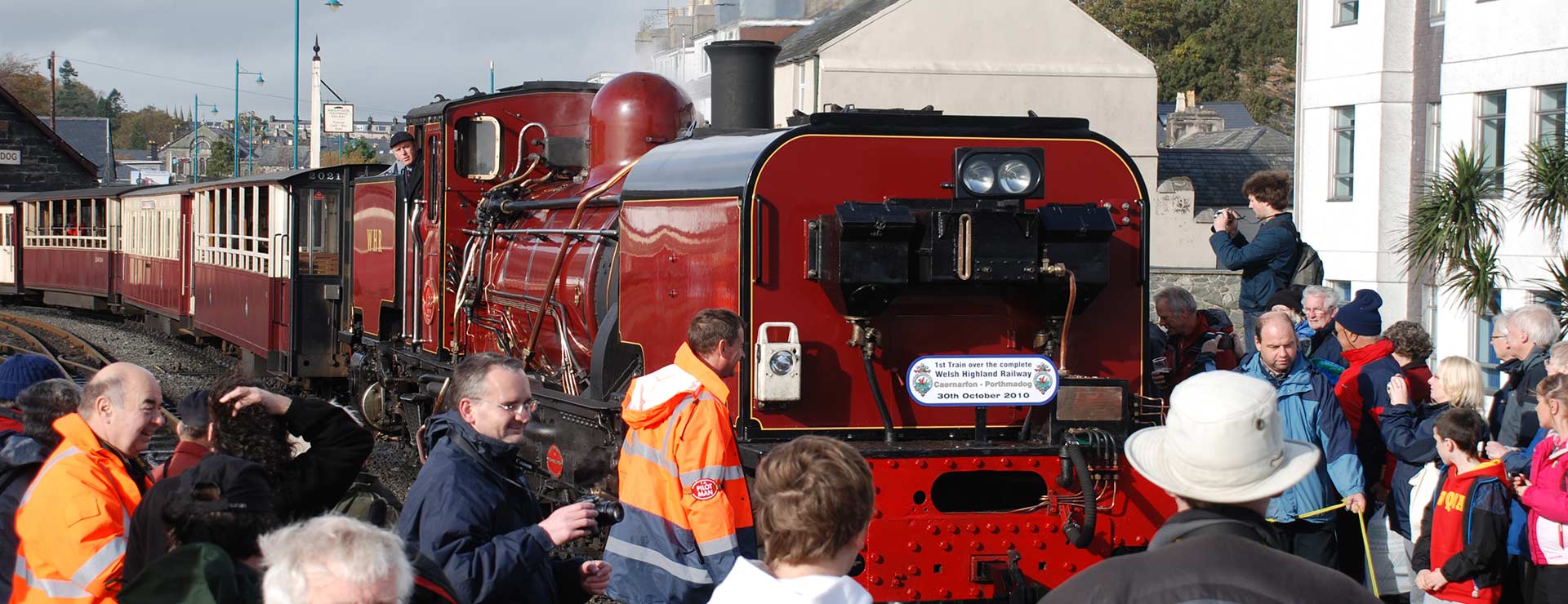
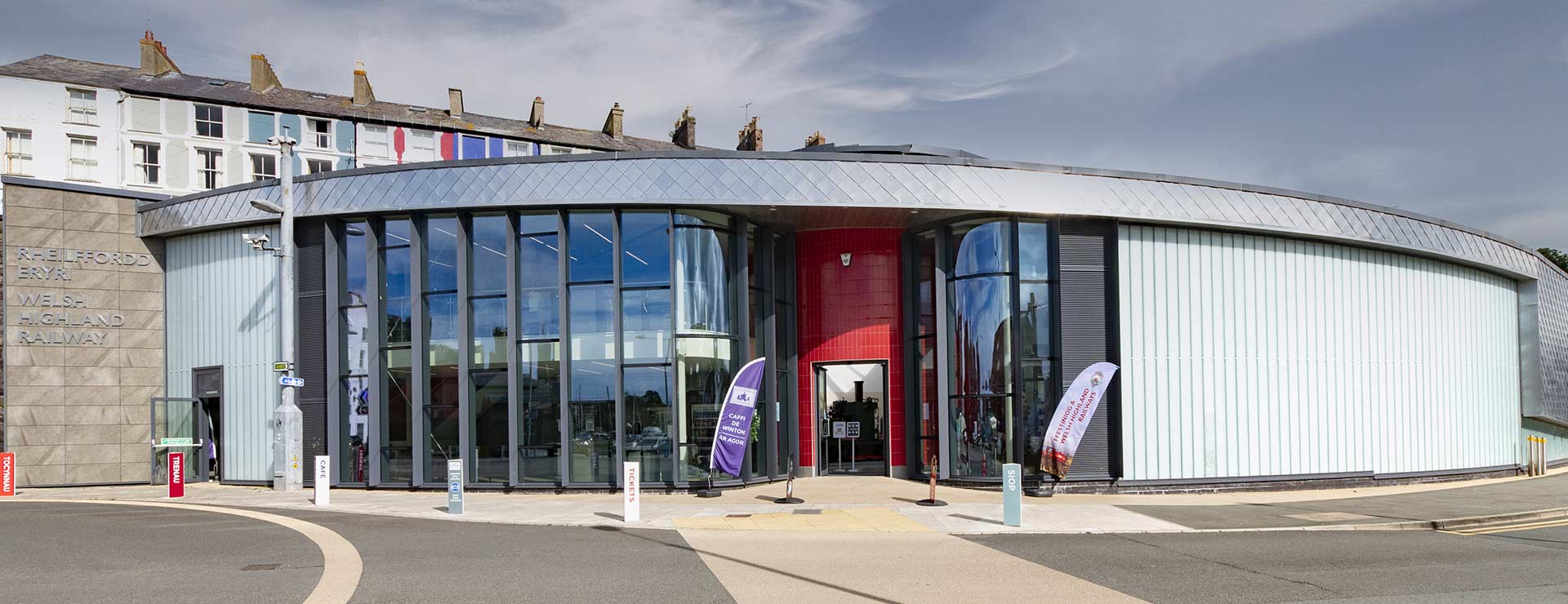
Since the Welsh Highland opened in the town in 1997, when it ran just three miles to Dinas, the 26-mile line – the UK’s longest heritage railway – has been extended in stages, finally opening to Porthmadog in 2011. Throughout that time, Caernarfon Station had been a temporary structure.
The new £3m station – part-funded by the European Regional Development Fund through the Welsh Government – forms a key part of the £16m Waterfront Development Project led by Gwynedd County Council to give a major boost to this historic area. The striking and distinctive building offers much improved facilities for visitors arriving by road from around the country or by rail from Porthmadog, where a major station improvement project was completed in 2014.
Initially the railway held a number of public consultation events in the town to canvass ideas and suggestions from local residents and visitors into the new two-storey design, which includes retail space, a spacious modern interpretation area showcasing the history of the quayside area and the railway, and of course the new ‘Caffi De Winton’.
After much deliberation, the final design was signed off and groundwork and construction commenced in February 2017. As is the case with many major infrastructure projects, there were unexpected setbacks – Work came to a standstill when a long forgotten gas main was discovered under the site, and the pipe had to be re-routed before construction could resume.
The public got their first glimpse of the new station when it opened on a limited basis for the Santa Trains during December 2018, and each day between December 27th and January 1st for trains running to Rhyd Ddu. It has been fully open since the start of daily services at the end of March 2019.
The new station at Caernarfon will help to increase visitor numbers to the Ffestiniog and Welsh Highland Railways by an estimated 5,000 passengers each year. The Ff&WHR already provides significant benefits to the wider local economy, generating an estimated £25m each year.
